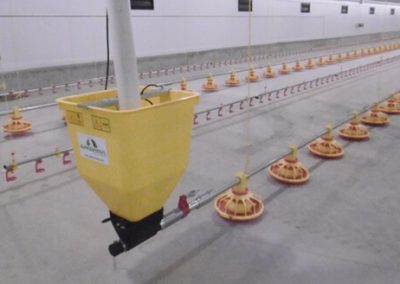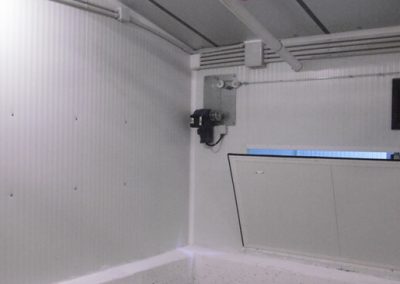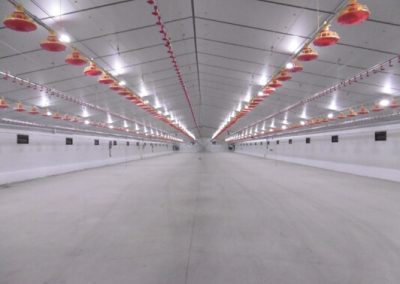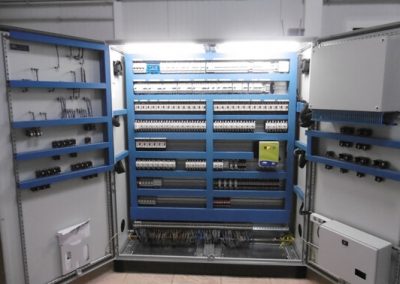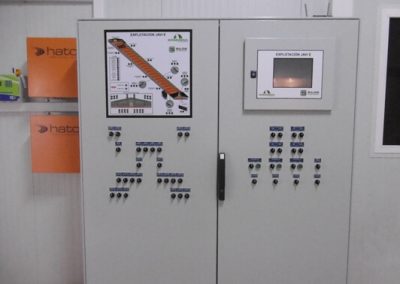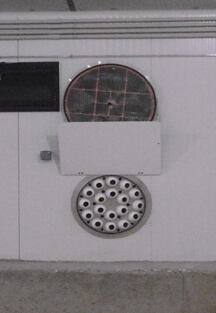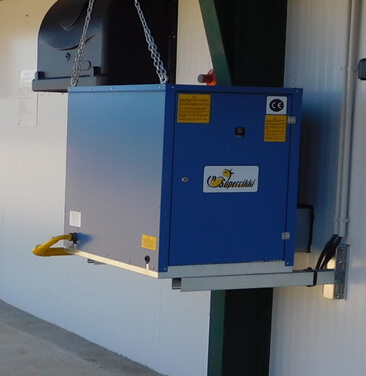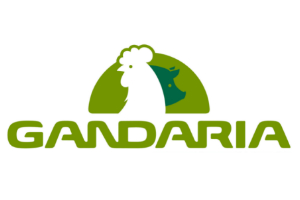Silos Córdoba

Two 100×17 meter facilities with a 5×17 meter technical room located between both facilities. Each facility has a production surface of 3,440 m2.
Year 2019.
The project includes
Two facilities built with IPE structure, sandwich panelling for roof and façades, PURAL false ceilings, aluminum doors and windows with sandwich panelling.
Sealing. Concerning the finishes, all wall joints are sealed with polyurethane foam and concave sanitary profile to avoid corners that can accumulate dirt.
Transitional ventilation windows are made of polyurethane with an internal iron reinforcement to prevent deformation and, outside, independent windbreak hoods have been installed. The air inlet of the tunnel is made on site using PVC profile and sandwich panelling topped with rubber gaskets to ensure tightness, a rack arm system allowing it to open and close, guaranteeing the uniform operation required in these kind of facilities where we focus on the precision of all systems.
Ventilation and cooling system including 4 heat exchangers in each facility with a removable aluminum core for easier cleaning and maintenance. The 4 devices perform minimum ventilation saving an average of 30% on heating and reducing both the humidity and CO2 considerably. For maximum ventilation, 16 fans of 43,000 m3/h have been installed in each facility at the opposite end to the cooling. Ventilation setup will be running in the transitional ventilation mode when the minimum needs have been met and until animal growth or the weather conditions require a change to the tunnel ventilation mode. Eight stainless steel cooling units have been installed (4 independent modules of 4.8×2 meters on each side) for heat control. Each module has a water tank and a pump, thus reducing any problems that may occur in traditional systems with one tank and one pump per side.
Heating is done with propane gas by 3 external devices per facility, thus providing a stable and uniform temperature to ensure the distribution of the chicks throughout the farm.
Climate control, including indoor and outdoor probes, humidity sensors, pressure meters and CO2 probes, is able to change the operating parameters according to the temperature. It can be direclty operated, with a touchscreen for viewing or changing the program, or remotely via a mobile phone or a tablet.
Electrical panel. It allows us to see the operation of the farm upon entering the facility through a synoptic that shows us the active systems or a breakdown if there is one, and it gives us the option to work automatically or manually activate any system. This panel is made with finest quality components and is manufactured in the electrical department of Gandaria with special care, as it’s a fundamental piece for the proper functioning of the farm, it is the heart of the facility, driven by the controlling brain: the computer. Both systems must be fully reliable.
The lighting consists of 4 rows of led lights exclusively designed for raising chickens, providing a beam of light with the appropriate wavelength, adjustable from 0 to 100 x 100. Each facility has 160 bulbs with a maximum consumption of 1 KW/h. The uniformity of lighting achieved is above 90%.
Electrical installation. It has been made with independent tubes for each line of power and control. These tubes are oversized for the incorporation of other possible systems in the future, and the sectorisation allows us to detect possible electrical failures independently and fix them easily. This is more expensive because of the labor and material used but very convenient for this type of installation and cost-effective in the future.
Water management. The control of drinking water is made through a panel specially designed according to the farm’s needs. This panel in particular has a pressure pump for uniformity in the water intake and to ensure the necessary flow, a pulse counter to show the amount of water consumed on the computer, an acid pump for the incorporation of acids, a chlorinator for the purification and of course, a drug mixer to supply mixtures adapted to the animals.
Feeders. They are GAN 14, a model that has proved its effectiveness from the first day of life of the chicks until the end of the fattening period, with more than 90.000 units installed in farms. The GAN 14 plates are installed on 1.5 mm galvanised steel tubes, Gandaria being the only company that uses this thickness. The union of these tubes is made by a metal band of 200 x 1.8 mm. which gives a reinforcement to the joint and gives greater rigidity and continuity in the line, avoiding friction and therefore breaks. The 4 lines installed are each fed by a plastic hopper without corners and are controlled by an external weight sensor that avoids contact with the feed found in other traditional systems. Each hopper requests feed independently, which is achieved by installing a specific drop that prevents the food going to the next hopper.
Troughs. The troughs are fitted nipple and recuperator, faithful to Gandaria’ philosophy of providing the maximum amount of water in the shortest possible time, thus avoiding the animals fatigue. Therefore, we have installed super high flow multi directional stainless steel teats: 5 lines with a total of 1,920 units. We do not skimp on number or quality, since access to water, which is normally double the consumption of feed, is fundamental. In both cases, feeders and drinking troughs, weights are installed in the general lifting cables that prevent their torsion, achieving a uniformity in the rise and fall of lines. For the lifting system, we have opted for manual winches in drinking troughs and electric winches in feeders.
Silos. To complete the feeding system, three 15 tons silos have been instlaled in each facility. These farm silos are pre lacquered in green to comply with environmental regulations. The installation has a storage capacity for 90,000 kgs. of feed, that is supplied to the different hoppers independently.
Safety. The system safety is controlled in several ways. Concerning the computer, if it stops working, it automatically opens the windows and maintains maximum ventilation automatically, while we would be receiving an alarm signal in the mobile. We would also receive an alarm if the lines of feeders os conveyors are in operation for too much time or water consumption exceeds the parameters we set. A failure in the electrical network would turn on the safety generator and warn us of lack of external supply. The alarm center will provide us with all this information and other data we may need just by installing the corresponding sensors, like the human presence detector, for instance.




